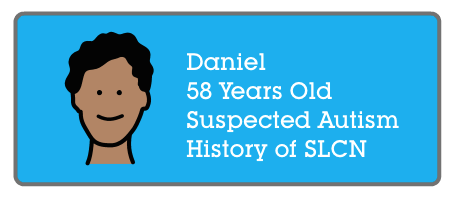Case One

About Daniel
Daniel was referred to Integrated Treatment Services (ITS) for the assessment of his language, following reported concerns of difficulties with understanding and using language, and difficulties with eye-contact. On referral, Daniel was also deemed as having little cognition. These difficulties have reportedly been present for the whole of Daniel’s life, with no known medical or developmental conditions that could be perceptibly contributory. There is no known family history of Speech, Language and/or Communication Needs (SLCN). There is also no known record of Daniel having ever attended school.
Daniel was referred to ITS who matched him with a local ITS Speech and Language Therapist (SLT), Stavroulla Flourentzou.
On assessment, Stavroulla observed Daniel as having severe difficulties with using language, only communicating at single word level. Daniel was also observed as having severe difficulties with using eye-contact, as well as significant difficulties with social interaction. He was also observed as having little motivation to engage with the SLT, hyperactivity, reduced muscle tone in his face and reduced dentition. Together, these factors made it very difficult to ascertain whether or not Daniel was understanding language and, if so, at what level.
Daniel’s Eye Gaze Assessment
Shortly after, Daniel was referred for an eye-tracking cognition assessment. This involved using high technology Augmentative and Alternative Communication devices to track Daniel’s eye movements during an on-screen assessment session. On assessment, Daniel had difficulties with looking at the screen, requiring maximum verbal prompting to do so. He continued to present with hyperactivity, where he benefited from sensory feedback via a wobble cushion to help him concentrate. Occasionally, this hyperactivity made it difficult for the eye-tracking device to record Daniel’s eye-movements, but Daniel was able to use pointing as a secondary source of communication. He also had difficulties with looking at the screen, requiring maximum verbal prompting to do so.
During the eye-tracking assessment, Daniel was observed to have difficulties understanding language, particularly long and complex sentences. Throughout the assessment, Daniel was able to follow all the relevant information on the screen, as well as being able to participate in conversation with Stavroulla, where her language was broken down and simplified.
He was also able to reveal new and exciting information about himself, such as his love for race car driving.
The Results
Findings from these assessments have uncovered Daniel’s abilities, where he was previously assumed to have little cognition. Daniel is now receiving weekly, direct and one-to-one Speech and Language Therapy in his home. On initial assessment, Daniel was infrequently communicating at single word level. Four months later, and after working well with his family and Speech and Language Therapist, he is now able to communicate at sentence level with up to four key words. For example, in his therapy session last week, Daniel independently said “the man is eating a sandwich in the park”. He continues to work well and make great progress.
——-








